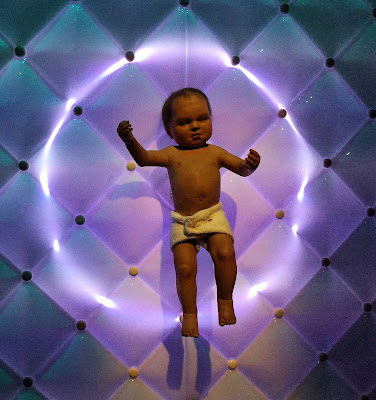Cute toys? Job thieves? Creepy threats to mankind? Robots, the Science Museum's latest exhibition, introduces many topical preoccupations.
As you stand in the lobby queue for your timed entry slot, you see two cute, toy-like robot ticket desks. One desk was initially unmanned on my arrival; the other had a long queue.
 |
No-one paid much attention.
Then, creepily... the eyeballs moved.
The first exhibit inside the entrance catches everyone by surprise. An animatronic baby raises a mix of emotions in visitors. So life-like. The eyes have the knowing look of an old soul seen in some new-borns. It moves like a baby. And yet, something is missing.
 |
| Visitors stand back from the animatronic baby |
The movements have a controlled pattern. No welling maternal instinct rushes to rescue the helpless creature from its stake on the wall. As blue lights change to pink and pink to blue, the urge is to step back and away instead.
Why? What makes a human baby such a unique creation? So utterly helpless at birth and yet a powerful learning machine. So determined without programming, yet some personality traits seem 'built in' from birth - or even before.
 |
| Close-up of animatronic baby in Robots Exhibition |
The Science Museum's Robots Exhibition takes you on a journey: Man's 500-year quest to make robots human. It leaves you asking questions about the current direction of robotics. It leaves you marvelling at the unique creation that is every single human baby.
 |
| Single-shuttle loom |
The first section is called 'Marvel'. It shows Man's early attempts at automation.
The second section 'Obey' presents the Industrial Revolution. It turned men into robots, servants of the machine.
 |
| ...And nothing can possibly go ... worng... |
 |
| Coordinating vision, recognition, reaction & movement - tough for a robot |
The sophistication gradually increases. Many robots in this section are not complete. We see an arm or a hand. They still cannot match smooth, instantaneous human movements.
 |
| Sophisticated robotic hands are no match for human hands |
The final section is entitled 'Imagine'. The robots on display are very recent productions for a museum. Robothespian dates from 2016. Science is moving so fast. AI's more recent and advanced developments are not on display.
As children and adults interact with the robots, many of today's concerns become apparent. The UK's Robothespian is irritating; the Italian robot shows off; the Japanese news-reading robot is unnerving. Pepper, the French companion robot, is so popular that a crowd forms tightly around her.
 |
| UK's Robothespian of 2016 |
There are safety issues. Each robot is sectioned off from other robots and the public. Industrial robots can now work collaboratively with humans. Robots aren't toys any more.
 |
| Toyota's Human Support Robot |
No single robot seems to combine all human activities and brain power as yet. It would need to be huge to do so. Remember the size of the original mainframe computers? Miniaturisation will come.
It is proposed that robots should become care-providers for the young and elderly - i.e. the most vulnerable in society. Do we want or need that?
Young children and the elderly with dementia are unpredictable. The mobility, determination and unpredictability of a news commentator's children went viral on Twitter this week. Are robots a match for this?
I also saw a video of children 'playing' with Alexa this week. They were running rings around her by proposing fake shopping list items. We would call it bullying, if Alexa were human.
How will we prevent artificial intelligence from learning how to bully? Do robots really need to take a human form?
Past
Blogs on Robotics:
Karen Andrews is a freelance French to English translator, transcreator, content writer and editor. She has a strong background in global marketing.
Email Karen for further information via karenanglicityen@gmail.com in French, German or English.

2 comments:
3X8 sheet metal prices near me - TITanium-Art
4X8 nano titanium babyliss pro sheet 4x8 sheet metal prices near me metal prices titanium mug near me - titanium watches TITanium-Art apple watch titanium
iu051 xn--aloyogaespaa-khb,dope snow ireland,alo yoga sweatshirt sale,lotto tennis clothes,russell bromley loafers,moon boot dámské černé,hrvatskavejatenisice,dope kurtka,botines lotto niños fi630
Post a Comment